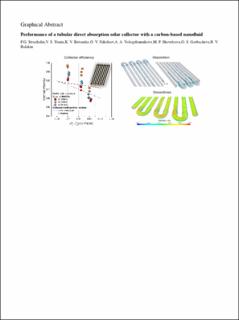| dc.contributor.author | Struchalin, Pavel | |
| dc.contributor.author | Yunin, Vladimir | |
| dc.contributor.author | Kutsenko, Kirill V. | |
| dc.contributor.author | Nikolaev, Oleg | |
| dc.contributor.author | Vologzhannikova, Alisa | |
| dc.contributor.author | Shevelyova, Marina | |
| dc.contributor.author | Gorbacheva, Olga | |
| dc.contributor.author | Balakin, Boris | |
| dc.date.accessioned | 2021-11-22T11:40:29Z | |
| dc.date.available | 2021-11-22T11:40:29Z | |
| dc.date.created | 2021-08-03T09:41:04Z | |
| dc.date.issued | 2021 | |
| dc.identifier.citation | Struchalin, P. G., Yunin, V. S., Kutsenko, K. V., Nikolaev, O. V., Vologzhannikova, A. A., Shevelyova, M. P., Gorbacheva, O. S., & Balakin, B. V. (2021). Performance of a tubular direct absorption solar collector with a carbon-based nanofluid. International Journal of Heat and Mass Transfer, 179. | en_US |
| dc.identifier.issn | 0017-9310 | |
| dc.identifier.uri | https://hdl.handle.net/11250/2830693 | |
| dc.description | This is an author's accepted manuscript version of an article published by Elsevier in International Journal of Heat and Mass Transfer on 19 July 2021, available from https://doi.org/10.1016/j.ijheatmasstransfer.2021.121717 | en_US |
| dc.description.abstract | Direct absorption solar collectors (DASC) with nanofluid represent a new direction in solar thermal technology that is simpler yet more efficient than conventional equipment. In this work, we report details of performance for a custom tubular DASC with a carbon-based nanofluid. The collector was tested experimentally following a standard procedure and using a multiphase CFD-model of the device. The experiments were carried out in a range of flow rates 2... 10 l/min, nanoparticle concentrations 0.0015... 0.082%wt., temperature differences (up to 29.3 degrees), and radiant heat fluxes. We found that, at a particle concentration of 0.01%, the collector demonstrated the average thermal efficiency of 80%. For the comparable temperature differences, the efficiency of DASC was 5.8... 37.9% higher than a collector with similar geometry but a surface absorption of light energy.
The CFD-model, validated against our experiments, depicts flow patterns in the DASC focusing on nanoparticles’ deposition. Less than 5% of particles deposit under local flow restrictions at flows above 6 l/min. The deposition patterns from the CFD-model correlate to the experimental observations. | en_US |
| dc.language.iso | eng | en_US |
| dc.publisher | Elsevier | en_US |
| dc.rights | Attribution-NonCommercial-NoDerivatives 4.0 Internasjonal | * |
| dc.rights.uri | http://creativecommons.org/licenses/by-nc-nd/4.0/deed.no | * |
| dc.subject | direct absorption solar collector | en_US |
| dc.subject | carbon nanotubes | en_US |
| dc.subject | nanofluid | en_US |
| dc.subject | CFD | en_US |
| dc.subject | solar collector | en_US |
| dc.title | Performance of a tubular direct absorption solar collector with a carbon-based nanofluid | en_US |
| dc.type | Peer reviewed | en_US |
| dc.type | Journal article | en_US |
| dc.description.version | acceptedVersion | en_US |
| dc.source.volume | 179 | en_US |
| dc.source.journal | International Journal of Heat and Mass Transfer | en_US |
| dc.identifier.doi | 10.1016/j.ijheatmasstransfer.2021.121717 | |
| dc.identifier.cristin | 1923546 | |
| dc.relation.project | Russian Science Foundation: 19-79-10083 | en_US |
| cristin.ispublished | true | |
| cristin.fulltext | original | |
| cristin.fulltext | postprint | |
| cristin.qualitycode | 1 | |

